Louis R. Bevier, Trevor B. Persons, Kyle A. Lima, Will Russell, and Douglas P. Hitchcox
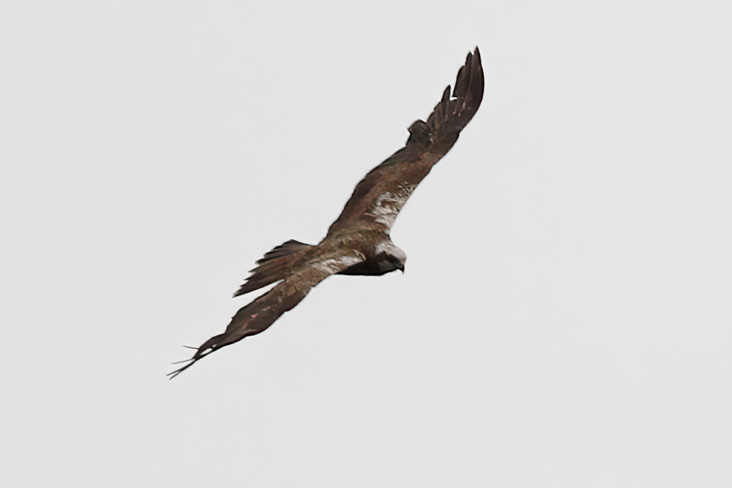
Adding to Maine’s list of extraordinary raptor visitors was this Western Marsh Harrier found on North Haven Island August 25, 2022, and relocated on the mainland in the town of South Thomaston at Weskeag Marsh the following two days. Photograph by Gary Jarvis August 27, 2022.
The Twelfth Report of the Maine Bird Records Committee (hereafter ME-BRC or the committee) summarizes 65 reports involving 37 species that were evaluated and decided during 2022. The committee accepted 61 records for an acceptance rate of 94%. Although many reports were recent, the years of occurrences ranged from 1975 to 2022. The committee continued its quest to review a backlog of historic reports, including here 20 such reports dating prior to 2018.
Three new species were added to the state list: Broad-tailed Hummingbird (Selasphorus platycercus), Steller’s Sea-Eagle (Haliaeetus pelagicus), and Western Marsh Harrier (Circus aeruginosus). Two species, White Ibis (Eudocimus albus) and Brewer’s Blackbird (Euphagus cyanocephalus), which had been provisionally placed on the official state list, received their first formal review and acceptance. The total number of documented species on Maine’s state list is now 470. The official list of bird species recorded in Maine, our review procedures, and the list of members can be found at the committee’s website: http://sites.google.com/site/mainebirdrecordscommittee.
Records in this report are grouped by species; records accepted and those not accepted are listed within the same species account. Each record provides the location, county (italicized), date(s) of occurrence, names of observers or contributors, and committee record number. Documentation was provided by the observers listed or, in some cases, was obtained from publicly published websites. All reviewed materials and member comments are archived. If known, the names of finders are listed first and separated from other names by a semicolon. Photographic, video, or audio evidence reviewed is denoted by a dagger (†); written notes are denoted by an asterisk (*). As always, the committee strongly encourages written submissions even when there are photographs. Species accounts follow the current taxonomic classification and sequence adopted as of 2022 by the American Ornithological Society (list available at http://checklist.americanornithology.org/taxa/).
Species Accounts
Pink-footed Goose (Anser brachyrhynchus). One was at Malabeam Lake in Limestone, Aroostook, October 21–24, 2021 (Bill Sheehan†; Ashlee Duff, Marian Zimmerman, Ethan Whitaker; 2021-041). Maine now has 16 accepted records, 7 of which are from Aroostook County, including 6 of those found by Sheehan.
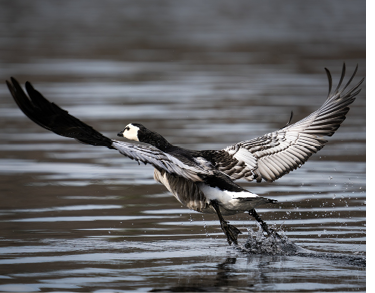
This Barnacle Goose, found in Rockland on November 5, 2021, was likely the same individual found at multiple locations in three counties through June 4, 2022, when last seen at Bangor. Photograph by Noah Rosen at Rockport April 25, 2022.
Barnacle Goose (Branta leucopsis). One visited Rockland, Thomaston, and Owls Head, Knox, November 5, 2021, to March 24, 2022 (Don Reimer†; 2021-043). After a month lapse, what was likely the same bird worked its way north to Rockport, Knox, April 25 and May 7, and Lincolnville, Waldo, June 2 (Noah Rosen†, Max Taylor†, and Lillian Amborn†, respectively; 2022-009). The last report was at Bangor, Penobscot, June 4 (Alice Doughty†; 2022-017). Linked as the same bird by the committee, this represents the ninth record for Maine (five awaiting review).
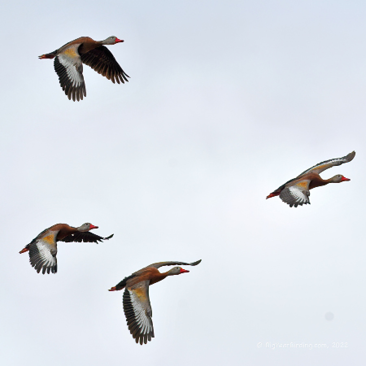
Maine’s fourth record of Black-bellied Whistling-Duck was a flock of 11 birds in Camden from April 27 to May 13, 2022. Photograph by Ethan Whitaker April 30, 2022.
Black-bellied Whistling-Duck (Dendrocygna autumnalis). A flock of 11 birds frequented the Megunticook River in Camden, Knox, April 27 to May 13, 2022 (Charlie Graham; Sean Hatch†, Ethan Whitaker†; 2022-007), providing Maine’s fourth accepted record. All but one of our four records involved multiple individuals.
Tundra Swan (Cygnus columbianus). Two adult Tundra Swans were at Little Ossipee Pond, Waterboro, York, November 16 to December 1, 2021 (Richard and Ruth Sevigny; Bob Crowley†, Ethan Whitaker†, Sean Theriault†; 2021-045). These might have been two of the three immature birds seen at the same locality the previous fall. A juvenile was at Range Pond, Poland, Androscoggin, November 24 to December 1, 2021 (John Aromando; Doug Hitchcox†, Rob Speirs†, Thomas Gonye†; 2021-053).
Eurasian Collared-Dove (Streptopelia decaocto). NOT ACCEPTED, IDENTIFICATION QUESTIONED: A tame individual visiting a feeder on Little Cranberry Island, Hancock, November 16 to December 10, 2021 (2021-046), showed plumage characters inconsistent with pure Eurasian Collared-Dove. Many escaped domestic forms of collared-doves have occurred in Maine, some labeled African Collared-Dove (S. roseogrisea) or caged birds derived from that species. In addition to the appearance suggesting an escaped hybrid or domestic form, vocalizations, highly useful for identification, were not heard.
Chuck-will’s-widow (Antrostomus carolinensis). Singing birds were audio-recorded at Rockland, Knox, May 19, 2022 (David Jickling†; 2022-011), and Swans Island, Hancock, June 25, 2022 (Brian Krafjack†; 2022-022). A trend of increasing spring and summer occurrences seems to be underway in Maine.
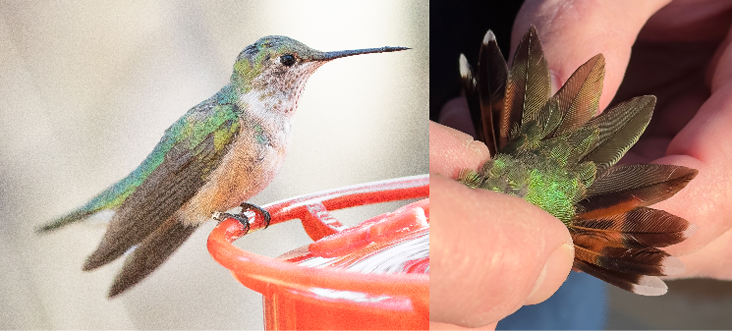
A first for Maine and New England, this immature male Broad-tailed Hummingbird was at Freeport from November 5 to December 23, 2022. Photographs by Doug Hitchcox November 21, 2022.
Broad-tailed Hummingbird (Selasphorus platycercus). An immature male was present at Freeport, Cumberland, November 5 to December 23, 2022 (Heidi Wolfe; Derek Lovitch†, Doug Hitchcox†, Scott Weidensaul†; 2022-042). This record is the first for Maine and New England, as well as only the third for the Northeast, with previous records for Delaware and New Jersey. In recent decades, the species has begun wintering sparingly along the Gulf Coast. This presaged vagrancy to the East of a species that breeds across the montane interior of the West, where highly migratory, and Mexico, where largely resident. Identification of immature and female Selasphorus hummingbirds is difficult. Here, thanks to Scott Weidensaul, banding allowed for diagnostic features to be documented—lack of rufous on the inner web of the first pair of tail feathers outward (R2s) from the central tail feathers (R1s) along with various linear measurements and plumage patterns. The call notes, which are higher and ‘tinnier’ than the smacking chip of Rufous or Allen’s Hummingbirds (S. rufus and S. sasin), also indicated Broad-tailed Hummingbird thanks to recordings by Hitchcox. From a distance, features such as the all-green upperparts from crown to uppertail coverts, broad and long central tail feathers, and uniformly broad primaries (usually noticeably narrowed toward outer primaries on Rufous and Allen’s) along with call note should help alert observers to any future vagrant. Toward the end of its stay, the bird had grown three rose-red gorget feathers.
Rufous Hummingbird (Selasphorus rufus). An adult male visited a feeder in Thomaston, Knox, July 22–24, 2022 (anonymous homeowner; Linda Cunningham†, Robin Ohrt†, and Zeke Smith*; 2022-024). There appear to be two occurrence peaks, one July–August and another late October–November, the former involving adults and the latter presumed immatures with a few known adults.
Black-necked Stilt (Himantopus mexicanus). One was at Scarborough Marsh, Cumberland, July 5–10, 2022 (Bill Oyler, Kevin Shannon; Sean Hatch†, Weston Barker†; 2022-021).
Northern Lapwing (Vanellus vanellus). Single birds were found on Vinalhaven Island, Knox, December 8, 2021 (Dalton McCoole†; 2021-050), and at Addison, Washington, April 2, 2022 (Thomas Gonye†, Tess Moore, Izabelle Grimm; 2022-005). There are now five accepted records, with one old report for 1927 still unreviewed.
Long-tailed Jaeger (Stercorarius longicaudus). Two first-summer birds were seen from a whale-watching boat ~30 km southeast of Jonesport, Washington, July 31, 2022 (Ethan† and Ingrid Whitaker; 2022-023). Because this species has been established to occur regularly off the Maine coast in late summer and early fall, it was subsequently removed from the Review List.
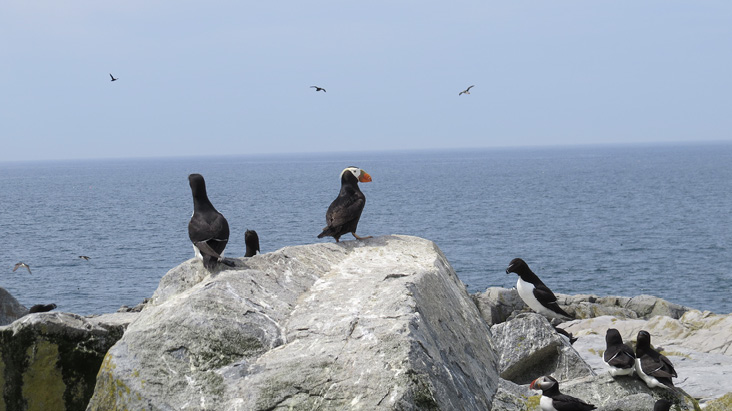
Perhaps the same Tufted Puffin seen during the summer of 2014 returned to the Gulf of Maine and briefly visited four seabird nesting islands from June 22 to July 15, 2022. Photograph by Nancy Walker from Machias Seal Island July 1, 2022.
Tufted Puffin (Fratercula cirrhata). Presumably the same Tufted Puffin was found on or near four seabird nesting islands in summer 2022 (2022-019): Petit Manan Island, Washington, June 22–23 (Kaiulani Sund†; Hallie Daly†, Ethan and Brennan Landreville†, Paula Struckman†); Machias Seal Island, Washington, July 1 (Nancy and Tim Walker†); Seal Island, Knox, July 5–6 (Dave Hof; Keenan Yakola†); and Eastern Egg Rock, Knox, July 15 (Daniel Rubianto*). This bird may have been the same one that visited the Gulf of Maine at Machias Seal Island in 2014. See Bevier (2017) for Maine’s two previous records.
Franklin’s Gull (Leucophaeus pipixcan). An adult was at Sabattus Pond, Androscoggin, May 22, 2022 (Nick Lund†, Edward Jenkins; 2022-12). This sighting is one of only three spring records for the species.
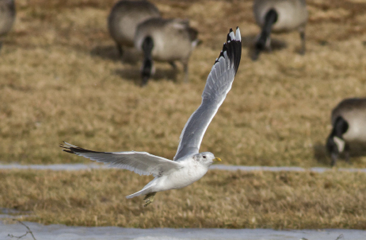
This Common Gull was at Eastport from February 17 to March 21, 2022. Photograph by Cameron Cox February 17, 2022.
Common Gull (Larus canus). An adult was at Eastport, Washington, February 17 to March 21, 2022 (Cameron Cox†, Allison Anholt; 2022-003). The primary pattern, important for identification, was scored using Adriaens and Gibbins (2016) by the observer and others independently. Determination to subspecies was inconclusive. The bird showed characters suggestive of Kamchatka Gull (L. c. kamtschatschensis), including size being nearly as large as nearby Ring-billed Gulls (L. delawarensis), some aspects of primary pattern (8 of 14 scored features favoring kamtschatschensis), long bill lacking an obvious dark band (though this feature can change with onset to breeding condition), and strong head streaking. Other characters conflicted with Kamchatka Gull or were more like nominate L. c. canus (or intermediates), including, for example, several primary pattern characters (6 of 14 scored features more like nominate canus), a paler gray mantle closer to nominate canus, and dark irides (found on only 14%, 11 out of 78, kamtschatschensis sampled by P. Adriaens, in litt.). Although this bird was possibly Maine’s first Kamchatka Gull, the committee did not find the evidence definitive. Of interest, the complete black band and its shape on the fifth primary combined with black dots on both webs near the tip of the fourth primary, a combined feature rare on nominate canus, was the same pattern shown by another Common Gull at Eastport in 2018, suggesting the possibility they are the same bird. The 2018 bird was accepted as nominate L. c. canus (2018-001). The committee may revisit these records in light of new information.
Pacific Loon (Gavia pacifica). One was off Cliff House in York, York, December 26–30, 2021 (David Nelson†; Louis Bevier†; 2021-051). This bird was reported last on March 4, 2022, but definitive evidence was lacking over most of the intervening period. This species is so frequently misidentified that members were reluctant to accept the full date span without better documentation. Another was at Monhegan Island, Lincoln, October 9, 2022 (Paul Doiron and Kristen Lindquist†; 2022-035).
Magnificent Frigatebird (Fregata magnificens). An apparent adult female was photographed over Matinicus Island, Knox, January 17, 2022 (Joe Bray†; 2022-002). Most of the committee agreed that features visible suggested this was the same adult female Magnificent Frigatebird seen January 2, 2022, on Nantucket, Massachusetts, which was supported by excellent photos. The same inward kink to an inner rectrix, a vague white extension on the side of the neck cut off by the dark nape and hindneck (typical of adult female Magnificent), as well as a dark spot in the white breast were noted as similar to the Matinicus bird. Although it is clearly a frigatebird, the Matinicus images are very poor quality, and one member felt the evidence was insufficient for identification to species. Any frigatebird in the northwest Atlantic Ocean during January is extraordinary, and the presence of a similarly patterned bird on Nantucket two weeks prior along with the linking characters noted were thought compelling for identification by most members.
Brown Pelican (Pelecanus occidentalis). This report came to light only recently and represents, by date, the fourth record for Maine. The summer of 2018 had two subsequent reports, but this record, the first, was at Christmas Cove, Southport Island, Sagadahoc, June 2, 2018 (Peg and Tim Helming†; 2018-048). There are now eight accepted records, with four very old reports (1826–1922) awaiting review.
White Ibis (Eudocimus albus). A flock of at least 30 juveniles frequented Webhannet Marsh and vicinity in Wells, York, August 10 to September 11, 2022 (Alexsandra Jean†; Joseph Peter Osterhoudt, David Nelson†, Linda Cunningham†, Susan Kline†; 2022-025). An injured juvenile found at Scarborough, Cumberland, August 29–31, 2022 (Allison Perry†; Doug Hitchcox; 2022-029), may have been from the Wells flock, but another juvenile at Lovell, Oxford, August 16, 2022 (Dean Banfield, Alvin Beck†; 2022-029), was perhaps a different bird. The number of birds involved was part of a wider and unprecedented northward dispersal for the species in 2022. The records above represent the first formally reviewed for Maine, but there are three previous records involving single birds, two of which were photographed (one in 1984 and two in 1993; see ME-BRC website).
Western Marsh Harrier (Circus aeruginosus). An alternate English name is Eurasian Marsh-Harrier. An immature female slightly more than one year old and molting into its second basic plumage (fide John Schmitt in litt.) was found on the island of North Haven, Knox, August 25, 2022 (Byron Swift†; 2022-028). Remarkably, the bird was found the following day by Evan Obercian on the mainland at Weskeag Marsh, South Thomaston, Knox, August 26–27, and seen by at least 60 birders over those two days (Gary Jarvis†, Henry Mauer†, Lisabeth Southworth†; as throughout this report, those listed here have archived their images with the committee, but other images and notes may be found in eBird and were reviewed). A similar, subadult female in molt to second basic plumage was found 350 miles southwest in Morris County, New Jersey, November 8–12, eleven weeks after the Maine occurrence. Given the similar age, pattern on the inner upperwing coverts (notably alike on right wing), and stage of molt, these are likely the same bird. The whitish crown seen in Maine had apparently molted in brownish streaks on the crown, typical of adult females, but the eye was still brown and not yellow, typical of first basic marsh harriers. Of the seven previous records for this species in the Western Hemisphere, most in the Caribbean and Bermuda, those identifiable to age were juveniles, some of those over-wintering. Therefore, the age of the bird seen in Maine and New Jersey is novel and further suggestive that they are the same bird. This bird’s journey apparently ended when it was struck by a jet landing at Newark, New Jersey, November 19, with partial remains and DNA identification confirmed by the Feather Identification Lab at the National Museum of Natural History (C. Dove in litt.; event 2022-11-19-213703, https://wildlife.faa.gov/edit).
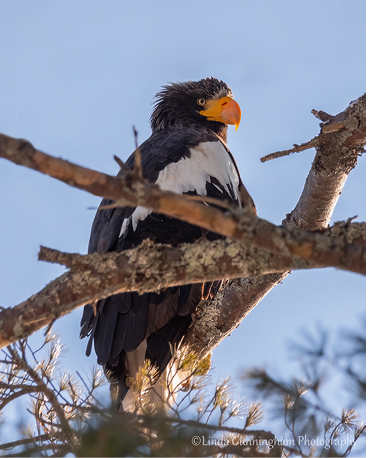
Arguably North America’s most famous bird of recent years is the wandering Steller’s Sea-Eagle that wintered along midcoast Maine from at least December 30, 2021, to March 5, 2022. It returned to the area on February 5, 2023, and remained through February 14. Photograph by Linda Cunningham at Boothbay Harbor January 8, 2022.
Steller’s Sea-Eagle (Haliaeetus pelagicus). The same adult that was first seen in North America along the Denali Highway in Alaska August 30, 2020, apparently traveled across the continent before arriving at Georgetown, Sagadahoc, in late December 2021, with the first photo taken December 30 (Linda Tharp†; 2021-054). This eagle’s intervening travels from Alaska to Texas, the Canadian Maritimes, Massachusetts, and finally Maine were chronicled by Schibley and Iliff (2022). During its stay in Maine, several thousand birders enjoyed the bird at Georgetown and then both Boothbay and Pemaquid harbors, Lincoln. On January 3, 2022, the bird was photographed southwest at Harpswell, Cumberland. The last confirmed sighting in Maine was March 5, 2022 (archived images submitted by Louis Bevier†, Linda Cunningham†, Doug Gochfeld†, Doug Hitchcox†, Zachary Holderby†, Jon Lewis†). Since the bird’s departure in spring 2022, what was presumably the same bird appeared in Newfoundland during summer and then in late November in Kent, New Brunswick. Given the history of a Steller’s Sea-Eagle returning for 16 consecutive summers in Alaska (from June 1987 to September 2002), it seems possible this individual might remain in northeast North America, wintering in New England and summering in the Canadian Maritimes.
Swainson’s Hawk (Buteo swainsoni). NOT ACCEPTED, IDENTIFICATION QUESTIONED: The description of a dark morph reported migrating with Red-tailed Hawks over Lincoln Center, Penobscot, October 26, 1976 (1976-004), was regarded unanimously as not detailed enough to eliminate other species and failed to note pale undertail coverts expected even on dark-morph Swainson’s Hawks.
Eastern Screech-Owl (Megascops asio). NOT ACCEPTED, IDENTIFICATION QUESTIONED: One was reported heard at Hampden, Penobscot, September 30, 2021 (2021-037). The committee unanimously decided not to accept this report given it was heard only and at great distance. The location is far north of where the species is expected in Maine. A voice recording, easily obtained these days with smartphones, is necessary for acceptance of this species outside its known range. Because screech-owls are apparently resident in York and Cumberland counties, the committee will no longer review reports.
Ash-throated Flycatcher (Myiarchus cinerascens). A well-documented bird was present at Biddeford Pool, York, November 7–17, 2021 (Taj Schottland, Alan Kneidel†; Charles Duncan†, Weston Barker†; 2021-044). There are now 10 records, all but one of which occurred between October 21 and December 12.
Gray Kingbird (Tyrannus dominicensis). One at Fortunes Rocks Beach, Biddeford, York, December 3–15, 2021, was seen gorging on kelp flies, Coelopa sp., during its stay and represents the third accepted record (Loren Merrill†; Laura Blutstein†, Linda Cunningham†, Charles Duncan†, Robert Ohrt; 2021-047).
Fork-tailed Flycatcher (Tyrannus savana). An adult at Kennebunk Plains, York, June 27, 1994 (Joe Bear†, Brian O’Toole, Patrick Dugan; 1994-006), was thought possibly to be the same bird seen a month earlier at Kittery (previously accepted 1994-005; Despres and Brinker 1994). The Kittery bird was in molt whereas the Kennebunk Plains bird was fresher and with an apparently full tail. More recently, an adult was at Machias, Washington, September 23–28, 2022 (Margaret Pinsky†; 2022-031). Although both of the above were photographed, subspecific identity was not determinable.
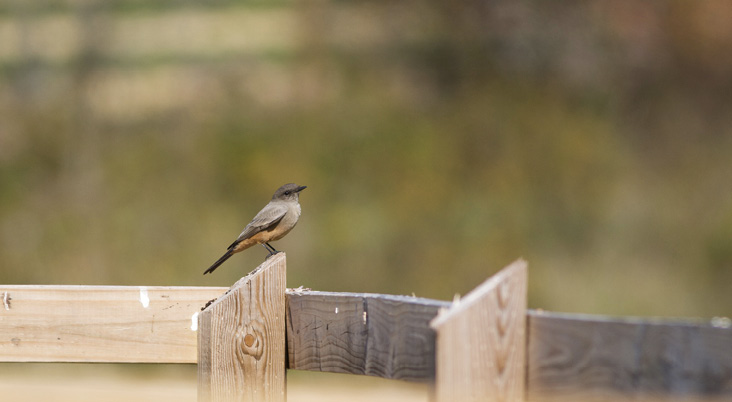
This Say’s Phoebe was a one-day wonder at Belfast October 3, 2022. Photograph by Kyle Lima.
Say’s Phoebe (Sayornis saya). One was at Belfast, Waldo, October 3, 2022 (Serena Ross, Kyle Lima†*; 2022-032).
Northern Wheatear (Oenanthe oenanthe). The mouth of the Mousam River, Kennebunk, York, now has three records of this species over 10 years—2012, 2020, and 2022. The most recent was present September 11–15, 2022 (Ken Janes†, Bill Grabin†; Cameron Johnson†; 2022-030).
Harris’s Sparrow (Zonotrichia querula). One visited a feeding station at Kingfield, Franklin, October 26–27, 2021 (Trisha O’Connor†; 2021-042).
LeConte’s Sparrow (Ammospiza leconteii). NOT ACCEPTED, IDENTIFICATION QUESTIONED: An older, published account of a bird at Cape Elizabeth, Cumberland, November 9, 1992 (1992-003), had not previously been reviewed. Most on the committee felt the written description failed to eliminate Nelson’s Sparrow (A. nelsoni), which was not considered at the time of observation. Moreover, the observer was unaware of the rarity of LeConte’s Sparrow in Maine at the time of observation. Some members pointed to the description of a white median crown stripe as supportive, but this did not overcome other anomalies in the account. There are 10 reports of the species for Maine, with 5 accepted of the 6 so far reviewed.
Henslow’s Sparrow (Centronyx henslowii). Two singing males took up residence in a preserved grassland parcel at Brunswick, Cumberland, July 5 to August 2, 2022 (Gordon Smith†; Weston Barker†, Bruce Cole†, Gary Jarvis†, Jay Pitochelli†; 2022-020). Despite consistent and determined singing by these two birds, no evidence of breeding was observed. The committee accepted a well-described report of a singing bird also at Brunswick, July 21, 1986 (Peter Vickery*, Jeff Wells*; 1986-006; Despres 1987).
Bullock’s Oriole (Icterus bullockii). An immature female was at Nobleboro, Lincoln, early December 2021 to January 26, 2022 (Jeff Cherry†; Becky Marvil†; 2021-055). It had been present apparently for about three weeks before being found and identified by Cherry on December 27, 2021.
Brewer’s Blackbird (Euphagus cyanocephalus). Maine’s first accepted record was an adult male photographed and well described on Monhegan Island, Lincoln, September 24–25, 1985 (Kyle Jones†; 1985-004; Forster 1986). Three reports await review.
Golden-winged Warbler (Vermivora chrysoptera). The committee reviews reports of this species from 2014 onward. The following seven older reports preceded that change in review status. All were birds banded at Appledore Island, Isles of Shoals, York, with photos of each courtesy David W. Holmes, a longtime bander there: September 4, 1983 (1983-004); September 7, 1986 (1986-008); August 26, 1996 (1996-009); September 6, 1996 (1996-008); August 28,1998 (1998-003); August 29, 1998 (1998-004); and September 8, 2004 (2004-009).
MacGillivray’s Warbler (Geothlypis tolmiei). One was at Rockland, Knox, December 18, 2021 (Evan Obercian*; 2021-049).
Kentucky Warbler (Geothlypis formosa). The following older records were of birds banded at Appledore Island, Isles of Shoals, York, with photos of each courtesy David W. Holmes: August 18, 1975 (1975-003); August 30, 1983 (1983-003); August 19, 1986 (1986-007); August 16, 1990 (1990-007); August 20, 1996 (1996-007); September 4, 1998 (1998-002); and August 22, 2019 (2019-058).
Cerulean Warbler (Setophaga cerulea). The following records were of birds banded at Appledore Island, Isles of Shoals, York, with photos of each courtesy David W. Holmes: August 13, 1975 (1975-002); May 30, 1984 (1984-003); September 6, 1992 (1992-004); August 20, 1997 (1997-005); August 22, 2018 (2018-049); and August 19, 2019 (2019-057).
Townsend’s Warbler (Setophaga townsendi). One was at Cape Elizabeth, Cumberland, January 8–27, 2022 (Jim and Debbie Schultz†; 2022-001). Another was on Monhegan Island, Lincoln, May 26, 2022 (Maili Waters, Luke Seitz†*, Jeremiah Trimble†; 2022-013), this spring record being among very few for the Northeast.
Acknowledgements
As ever, the committee acknowledges with thanks and deep appreciation the submissions of documentary evidence provided by the observers cited above. The committee thanks Steve N. G. Howell for advice on frigatebird identification and John Schmitt for evaluation of the Western Marsh Harrier. Special thanks are due to Carla Dove, Program Manager of the Feather Identification Lab at the National Museum of Natural History, for providing information on the bird strike involving the Western Marsh Harrier. We wish to thank our fellow committee members for comments on the draft and our secretary, Becky Marvil, without whom these reports would not be possible.
References
- Adriaens, P., and C. Gibbins. 2016. Identification of the Larus canus complex. Dutch Birding 38 (1):1–64.
- Bevier, L. 2017. Sixth Report of the Maine Bird Records Committee. Bird Observer 45 (2):96–104.
- Despres, J. 1987. Highlights, June, 1985 – February, 1987. Maine Bird Notes 1 (2):20–25.
- Despres, J., and L. Brinker. 1994. The Nesting Season: 1 June – 31 July, 1994. Maine Bird Notes 7 (2):40–44.
- Forster, Richard A. 1986. The Autumn Migration: New England Region. American Birds 40 (2):254–260.
- Schibley, L., and M. J. Iliff. 2022. Steller’s Sea-Eagle (Haliaeetus pelagicus) visits Massachusetts for a first state record. Bird Observer 50 (1):6–22.